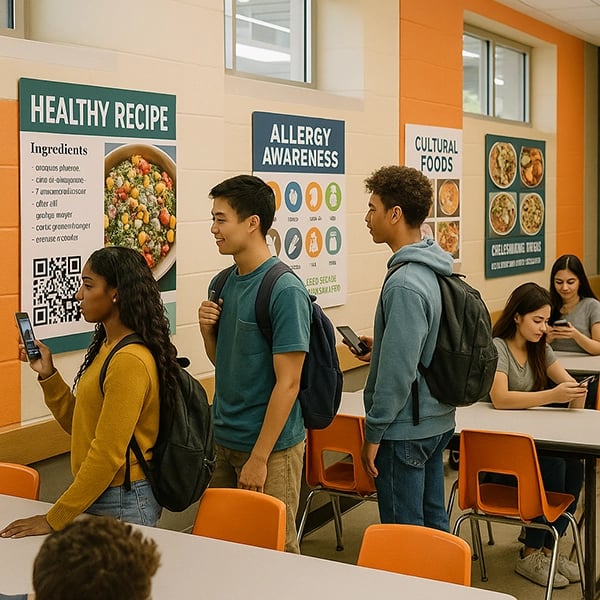School Poster Maker for Nutrition Stations
Why Visual Nutrition Education Works
As an educator with over 15 years in the field, I’ve seen firsthand how visual learning transforms student engagement. When it comes to nutrition education, traditional pamphlets and lectures often fall flat with teenagers. However, strategically placed poster stations created with a Campus Pro 36 Poster Maker Advanced Package can capture attention and inspire healthier choices.
Research shows that students retain 65% of visual information compared to just 10% of auditory information. By combining eye-catching designs with interactive elements like QR codes, we create learning experiences that stick. Furthermore, when students see their diverse food cultures represented in cafeteria displays, they feel valued and more connected to their school community.
The beauty of using a classroom poster maker lies in its flexibility. You can update displays seasonally, respond to student interests, and celebrate various cultural food holidays throughout the year. Additionally, involving students in the design process turns passive observers into active participants in their wellness education.

Creating vibrant nutrition displays with professional poster makers
Essential Components of School Poster Maker Nutrition Stations
QR-Enabled Recipe Cards
Connect posters to digital contentInteractive Learning
Students scan codes to access healthy recipes, cooking videos, and nutritional calculators. This bridges physical displays with digital resources, meeting teens where they are—on their phones!Allergy Awareness Zones
Critical information at a glanceSafety First
Clear, color-coded posters highlight common allergens, cross-contamination risks, and safe alternatives. Visual cues help students quickly identify safe food choices.Cultural Food Celebrations
Honor all dietary traditionsDiversity Matters
Monthly rotating displays celebrate diverse food traditions, from Ramadan iftar meals to Lunar New Year foods, promoting inclusivity and cultural awareness.Nutrient Spotlights
Break down complex nutritionScience Made Simple
Weekly features on specific nutrients use infographics to explain benefits, food sources, and daily requirements in teen-friendly language.Creating QR-Code Enabled Recipe Posters
The magic happens when static posters become gateways to dynamic content. Here’s how to create effective QR-enabled nutrition displays:
First, design your poster with a clear visual hierarchy. The main message should be readable from 10 feet away—think “Try This Week’s Heart-Healthy Recipe!” in bold, colorful text. Below that, feature an appetizing food photo (yes, teenagers eat with their eyes first!).
Next, generate QR codes that link to mobile-optimized content. I recommend creating a simple school nutrition website or using Google Sites where you can host recipes, cooking videos, and nutritional information. Pro tip: test every QR code with multiple devices before printing!
When using a Classroom Pro 24 Poster Maker Advanced Package, you can print these posters on durable coated paper that withstands the cafeteria environment. The key is making the QR code large enough (at least 2 inches square) and placing it where students naturally pause—near the lunch line or on dining tables.
Designing Effective School Poster Maker Nutrition Stations: Layout Strategy
Position stations at entry points, serving lines, dining areas, exit zones, and recycling stations for maximum visibility.
Use green for go (healthy choices), yellow for moderation, and red for allergen warnings consistently across all displays.
Rotate featured recipes and cultural spotlights bi-weekly to maintain engagement and showcase diversity.
Allergy Awareness Display Excellence
Creating effective allergy awareness displays requires both clarity and sensitivity. Start with the “Big 9” allergens that account for 90% of food allergies: milk, eggs, fish, shellfish, tree nuts, peanuts, wheat, soybeans, and sesame.
Design each allergen poster with a distinct color and icon system. For instance, use a blue wave for fish/shellfish, a wheat stalk for gluten, and a peanut icon that’s universally recognized. The Amplify Poster Maker produces crisp, clear graphics that ensure these critical safety symbols are easily identifiable from across the cafeteria.
Include positive messaging alongside warnings. Instead of just “Contains Nuts,” add “Try our delicious nut-free alternatives!” This approach reduces stigma while keeping students safe. Additionally, create companion posters showing cross-contamination prevention tips using simple infographics.
Consider laminating these critical safety posters using a Cold Laminator for durability and easy cleaning—essential in high-traffic food service areas.

Clear, color-coded allergy information saves lives
Celebrating Cultural Dietary Diversity
One of the most powerful aspects of cafeteria nutrition stations is their ability to celebrate the rich tapestry of dietary traditions in your school community. Here’s how to create inclusive displays that honor diverse food cultures:
Feature traditional dishes like pozole, mole, and fresh salsas with nutritional breakdowns showing their health benefits—like the protein in beans and vitamins in fresh peppers.
Highlight the diversity within Asian foods—from Japanese bento boxes to Indian dal to Vietnamese pho—emphasizing vegetables, lean proteins, and whole grains.
Showcase nutrient-rich dishes like tabbouleh, injera with lentils, and tagines, explaining how spices provide antioxidants and flavor without excess sodium.
Implementation Timeline and Budget Considerations
Let me share a practical timeline that’s worked well in schools I’ve partnered with:
Month 1: Survey students about their food preferences and cultural backgrounds. Form a student nutrition committee to help design posters. This buy-in is crucial for success!
Month 2: Create your first set of posters focusing on universal themes like hydration and whole grains. Start simple with 10-15 posters using your classroom poster maker. Budget approximately $200-300 for initial materials if using a school poster maker with standard materials.
Month 3: Launch QR-enabled recipe cards and begin rotating cultural food celebrations. Add 5-7 new posters monthly to keep content fresh.
Ongoing: Update allergen information seasonally and rotate cultural spotlights monthly. Budget $50-75 per month for materials and printing supplies.
Remember, investing in quality equipment like the Campus Pro 44 Poster Maker Advanced Package pays dividends through years of in-house poster creation. Many schools find funding through various sources including wellness grants and PTA support.
Ready to Transform Your Cafeteria?
Creating effective nutrition education stations doesn’t require a massive budget or design expertise. With the right school poster maker and a commitment to celebrating your students’ diverse backgrounds, you can transform your cafeteria into a vibrant learning space that promotes healthier choices every day.

